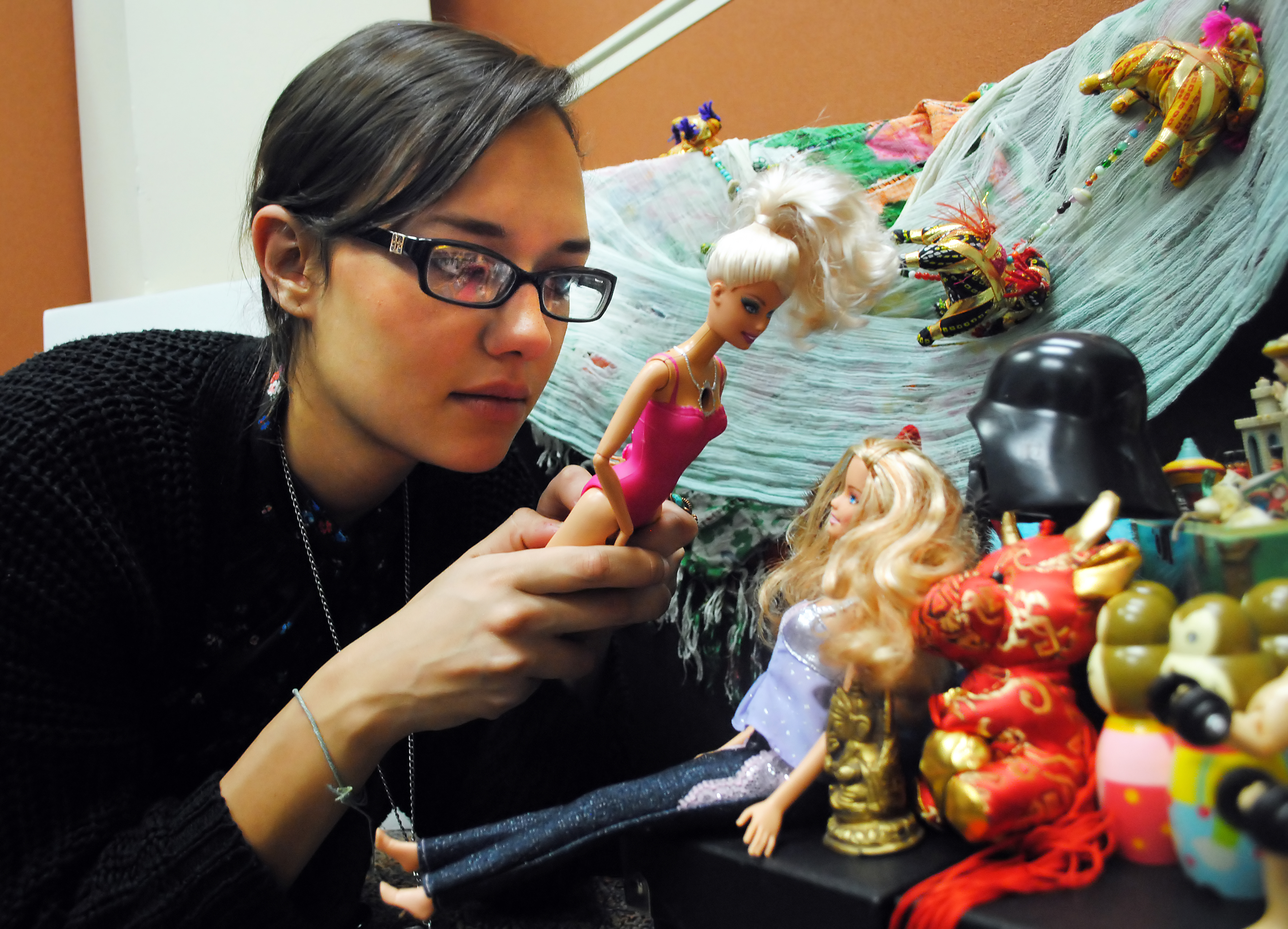The 1st Annual Barbie Film Festival will feature clips shot entirely with the video camera on the doll

UCLA alumna Nolwen Cifuentes uses a Barbie Video Girl doll to film her submission to the UCLA School of Theater, Film and Television-hosted Barbie Film Festival. Cifuentes’ film is a parody of an episode of the television show “The Twilight Zone.” The Barbie Video Girl features an embedded video camera located in the doll’s chest which presented student filmmakers with a new twist to the filmmaking process.
By Daily Bruin Staff
April 15, 2011 1:20 a.m.

The Barbie Film Festival, organized by the School of Theater, Film and Television, required that contestants create a film using Barbie Video Girl’s built-in camera.
When Professor Tom Denove first presented the idea of basing an entire film festival off of a children’s toy, no one believed him. Not even the company that made the hypothetical equipment.
“I contacted Mattel, and at first they didn’t take me seriously. They thought I was some crank caller,” Denove said.
Yet six months after the Barbie Video Girl doll was released on the open market, Denove and the School of Theater, Film and Television have crafted the Barbie Film Festival. Tonight, more than three dozen submissions will be on display at the James Bridges Theater, which Denove noted as an appropriate venue for films shot entirely on the Barbie Video Girl.
“It can screen everything from nitrate film to 4K digital, from 16-millimeter film to 70-millimeter and everything in between. Why not throw BarbieCam in the mix to just expand it a little more?” Denove said.
Unlike previous film-related accessories for the iconic doll, this latest model has the camera built into Barbie’s chest just below her neck. An LED readout takes up the entire area of Barbie’s back, similar to a viewfinder on a digital camera.
Before the April 8 deadline, entrance to the festival was open to any student, staff or faculty member in TFT. The only requirement was that the entire filming be done on the Barbie camera. Some students used video-editing programs like Final Cut Pro to craft the final results, but some opted to use the special software that Mattel developed specifically for Barbie. As an added bonus, anyone who submitted a finished film got to keep the doll.
Initially unsure about the response his project would receive, Denove quickly passed out all 40 of the Barbie Video Girls that Mattel had donated to the department.
When crafting their Mattel-enabled short films, the first thing a few of the participants noticed was that Barbie’s wardrobe proved to be slightly problematic.
“We had to unzip it because it kept getting in the way,” said graduate directing student Charlie Guillen. “Eventually, we said, “˜Barbie, you have to lose the jacket.'”
Another equipment obstacle stemmed from how Barbie gets her electric fuel. Batteries stored inside her thighs power the screen and the camera, but the students quickly discovered they ran dry very quickly. Rather than waste time removing and replacing the inner thigh panels that covered up the battery, many filmmakers chose to leave them exposed.
“With all the students carrying her around, she looked more like RoboBarbie,” Denove said.
Making videos was a hit with the TFT staff, many of whom were making their own first films. Nolwen Cifuentes, a UCLA alumna who works in the dean’s office, had previous experience in filmmaking and was happy to receive help and support from her co-workers.
“I built a Barbie house set with pink napkins and used wrapping paper for the wallpaper,” Cifuentes said. “Sometimes I had to lie on my back or duct tape her to a table to get the shot.”
In addition to the lightweight frame and handheld simplicity of the Barbie, the camera offers a technical component not seen on some of its bulkier, more expensive counterparts: a smaller auto-focus sensor that allows for an increased “depth of field.” This feature allows most objects in the Barbie-shot footage to remain in focus, whether they are in the foreground or background.
Armed with a new handheld challenge, some students decided to tackle some older material and pay homage to previous works. Cifuentes’ submission is a parody of a classic “The Twilight Zone” episode, while Denove said that another student reimagined a climactic scene from the 1987 film “Fatal Attraction.”
Simon Savelyev, a directing graduate student, used a varied array of attachments to shoot his film, employing a vacuum cleaner as a moving camera dolly while using a fish-eye lens adapter for some of his outdoor scenes. Savelyev’s film about a sentient household appliance even moved him to shoot on location on the Venice Boardwalk, a choice that gets to the heart of Denove’s intentions for the festival’s short preparation time.
“We only gave them a week on purpose, because we didn’t want them to overthink it,” Denove said. “Just go out and have fun without the pressure.”
Regardless of any potential prize, Guillen said the experience offered him the valuable chance to spend time with his 6-year-old daughter, whom he is often too busy to see.
“She thinks I’m completely insane,” Guillen said. “But I thought it would be fun for her first movie camera to be a Barbie doll.”

